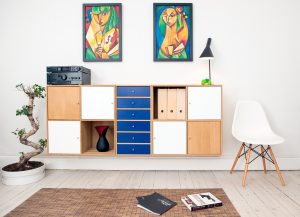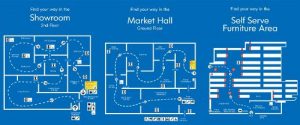Last updated 03-13-2020
By:
Natalya Bucuy
Katie needs a dress. So on a sunny Saturday, she sets out to find one. She already has a store in mind, the one where she always buys her dresses. She gets in the car, drives to the store, and rides the escalator to the second floor.
Once there, she gets a chance to look not only at dresses, displayed beautifully along the aisles. She also gets to see skirts, shirts, suits, and shoes. All arranged neatly, paired with cool accessories, hairstyles, and makeup looks. Katie gets excited. All these combinations and colors make her want to buy not just one, but two dresses, and that yellow blouse over there, and that flowery skirt to go with it.
As Katie walks down the maze of displays, she writes down the combinations she likes. She also writes down the numbers shown on each piece of clothing. She will need those later to find what she wants to purchase at the warehouse downstairs.
By the time Katie reaches the end of the displays, she is a bit tired and hungry – it took more than an hour to look at all the options. So she heads to the restaurant, which is conveniently located by the stairway.
Following a hearty lunch, Katie heads downstairs. There she will finally get her outfit. But not before she walks through another maze of shelves and hanging displays with more products, accessories, and options. This time Katie has a shopping cart with her. So when she sees something she likes she can now put it in her cart. And, sure enough, she does. A necklace here. A set of earrings there. A fabulous pair of shoes to go with the dress from over there.
Another hour goes by and Katie now arrives at a huge warehouse space. There on giant shelves, she finds matching numbers to those she has written down upstairs in the display room. Off the shelves, she gets bags of material, packaged neatly along with needles, thread, and buttons. Once she gets everything she needs, Katie pays for her purchases. As per usual, she leaves with more than just a dress she wanted. She carries everything to her car and, hours after her initial arrival at the store heads home.
There she will unpack her treasures, setting herself up in her living room and will sew together her new dress, almost from scratch. The packages from the store will have directions on how to do it. But Katie will still have to sew the pieces together, add buttons, zippers, and details to her outfit. Eventually, she will have her dress finished and ready to go. If she followed the directions correctly, of course. But those are not too complicated so she should be just fine…
Confused? Wondering what is wrong with Katie? Why didn’t she go to a normal store and just buy a completed ready-to-wear dress?
Yes, this not-so-easy shopping experience sounds a bit ridiculous in the contest of buying clothes.
Yet, consumers everywhere see nothing wrong with it and engage in it daily and happily all around the globe when it comes to buying furniture.
This is the concept of the world’s most successful retailer, IKEA.

A global leader in furniture sales, IKEA has 433 locations in 50 countries. In 2019, the retail giant employed 211,000 people worldwide, a 39% growth from 2013 (Statista)
Ingvar Kamprad, IKEA’s founder, started the business of selling household items back in 1943 in Sweden. At the time of his death in 2018, Kamprad had a net worth over $56 billion (Business Insider)
How did he do it? Moreover, how did IKEA continue its success on a global scale?
Here are some ideas….
1. Simplicity
“Simplicity is the ultimate sophistication” ~ Leonardo DeVinci

One of the most identifying features of IKEA is simplicity.
The furniture designs reflect minimalism and plainness of its Scandinavian origins. The brand reflects these values not only in its designs but in its overall business structure as well.
A simple, straightforward and down-to-earth way of being is part of our Småland heritage. It is about being ourselves and staying close to reality. We are informal, pragmatic and see bureaucracy as our biggest enemy. (IKEA)
For example, in the US locales, only a few executives have business cards and everyone is on a first-name basis (Research Methodology). Such employee culture ensures a casual, positive environment among staff. And that, in turn, results in higher furniture sales.
Take away for the rest of us:
Efficient simplicity throughout IKEA operations and designs set a good example of how less is more. Simple design lines appeal to the modern culture of minimalism and clean visuals. Uncomplicated leadership and management structure cut down on bureaucracy and unnecessary organizational clutter. These factors appeal to the new generation of shoppers and lead to successful furniture sales.
In other words, “Keep it simple, stupid.”
2. Strategic store layout
Anyone who has even been to IKEA is familiar with its specific layout.

Source: IKEA
The concept of the showroom is pretty self-explanatory. Shoppers get to see the furniture and accessories in action. Many furniture stores have showrooms. However, IKEA takes presentation to a whole new level.
When a new IKEA branch opened up in Brooklyn, the shopping experience proved to be so positive, even those shoppers who were aware of the strategic showroom design did not mind the upselling techniques it employed.
The IKEA Experience in one customer traffic heat map. The store isn’t too overwhelming, but it is overwhelming enough, with signs that direct customers in a disorienting maze, showing them so many products and making them spend so much time that they end up buying more than they planned on (Business Insider).
In fact, IKEA’s store design, together with friendly service from the employees, promotes a superior shopping environment. So much that it tops any other furniture shopping experience, both in-stores and on-line.
IKEA sells more than furniture – it offers a variety of household accessories and decor. The brand presents it all in a way that brings excitement not only about buying new items, but also about accessorizing and designing living space.

What makes IKEA store design so successful is the brand’s understanding of the buyer’s journey. The showroom’s efficient and practical displays and “the maze” help the buyers along the journey’s steps of awareness, consideration, and decision. As shoppers travel through the maze and see variations of the same pieces arranged in various ways, the chances of specific furniture sales increase. And the displays do such an excellent job at marketing the accessories, they sell themselves.
Before they know it shoppers who come in for the furniture sales end up leaving with not only the bed set they wanted, but the sheets and pillows as well.
Take away for the rest of us:
Displaying products in a way that showcases them to the buyer in a practical, efficient, and attractive way can increase furniture sales. Encouraging shoppers to see as many products as possible by directing them through a maze of displays promotes upselling.
3. Affordability
There is no question that low prices on furniture sales serve as the most attractive feature of IKEA.
The average IKEA customer’s age is mid-20s and early 30s, and 31% of IKEA customers average at 24 years old. According to one report most furniture shoppers abandon IKEA at the age of 34, which is an average home buying age in the United States (Vox).
Inexpensive furnishings attract the young customers. One can purchase a couch at IKEA for under $500, something unheard of in the rest of the world of furniture sales.
An interesting examination of IKEA pricing from Business Insider reveals the reasons for affordability:
- The brand sets a price it wants to sell a piece and its designers work around that
- IKEA uses inexpensive materials to make its furniture
- The company produces its products in bulk
- Flat packaging ensures easy transportation, storage, and buyer’s ability to transport pieces home
- By providing consistent experience at all its locations, IKEA employs few associates to oversee the furniture sales]
- Buyer’s ability to transport and assemble pieces themselves cuts down on costs

Take away for the rest of us:
Employing practices that cut down on production, transportation, and labor costs will allow affordable pricing. The company can pass along the savings to its consumer, which, in turn, will attract more buyers and facilitate more furniture sales.
4. Customer feedback
Like any successful company, IKEA listens to its customers and adapts its practices in accordance to customer feedback.
On its website and within its mobile app, the furniture sales conglomerate houses a whole section for customer feedback. There shoppers can report any issues with their in-store or online experiences and have them quickly resolved.
Certain IKEA branches, like the offices in Saudi Arabia, employ digital platforms to efficiently organize and address customer inquiries in real-time. Such digital platforms create omni channel customer communication opportunities.
But the brand does not just listen without action. In 2017, IKEA began implementing a different design that simplifies the furniture assembly. The change came as a response to customer feedback about the difficulty of putting some of the IKEA furniture together.

Take away for the rest of us:
Collecting feedback and listening to its customers is one of IKEA’s strategies that ultimately leads to increase in furniture sales. Whether it’s asking for reviews, requesting referrals, or simply inquiring about customer experience in the store with the use of feedback kiosks, a company can always work towards making sure it listens to its customers.
Bottom line
Over more than 70 years, IKEA has proven that its consistent practices can lead to successful furniture sales in almost every corner of the globe. Simplicity in designs and organization, affordability, strategic store layout, and listening to customer feedback are some of those successful strategies.

